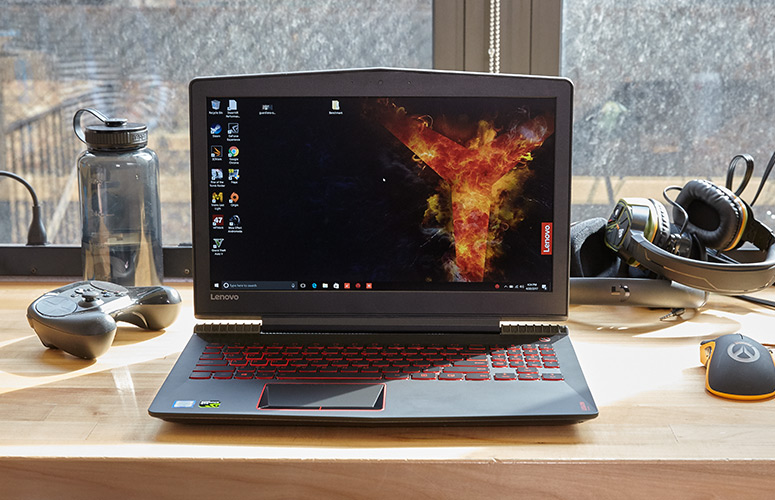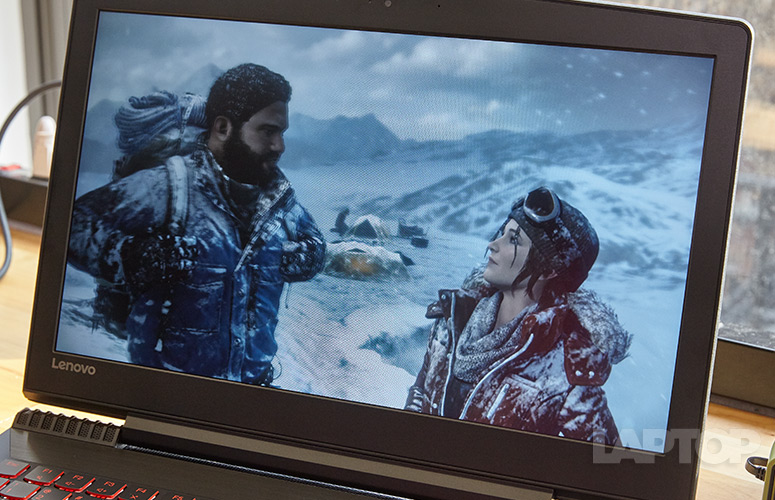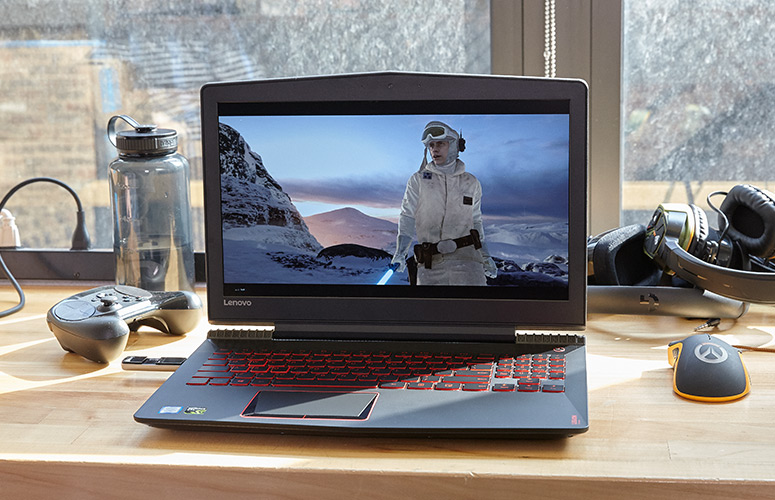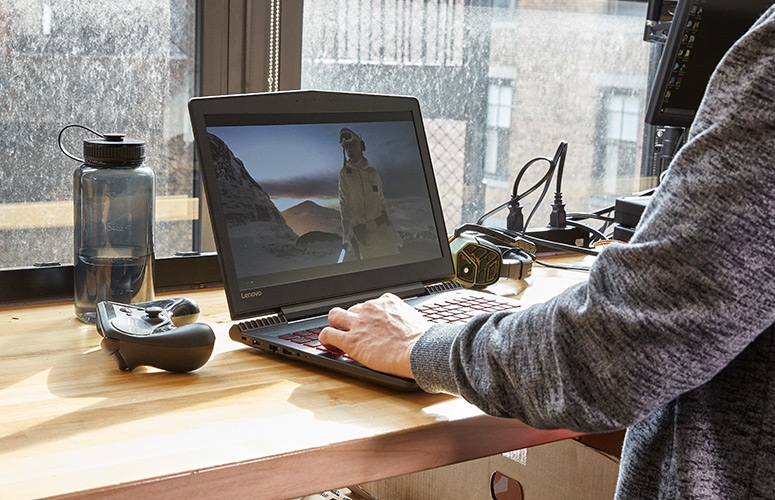Laptop Mag Verdict
The Lenovo Legion Y520 offers strong performance for its price and a sleek design. But its screen is dull, and its touchpad places form over function.
Pros
- +
Sleek design
- +
Comfortable keyboard
- +
Strong gaming and productivity performance
- +
Useful software
Cons
- -
Dull display
- -
Oddly shaped touchpad
Why you can trust Laptop Mag
The Legion Y520 ($849 to start; $1,249 as tested) isn't Lenovo's first gaming laptop, but it marks a fresh start for the company in that market. The Y520 is the inaugural member of the new Legion series, and it makes a strong first impression. The laptop's sleek, tapered look and the strong performance of its Intel Core i7 CPU and Nvidia GTX 1050 Ti GPU make it easy to recommend this machine to gamers on a budget. However, users will have to overcome some annoyances, including a dull screen and a poorly designed touchpad.
Design: Plastic Kevlar
I'm a fan of the subtle look Lenovo is going for with its new "Legion" line of notebooks. The lid is black plastic with a woven pattern and a few lines that make it look aggressive but still approachable. A series of grates on the back wrap around to the bottom of the computer and frame two sets of vents, which makes them seem more like an intentional decoration than a technological necessity. Although it's made of plastic, the Legion Y520 feels solid. It's unsurprising to see the material used in the chassis for a budget gaming notebook, but I do appreciate that it feels like I can jam it in a bag and not have to worry about it.

When you lift the lid, you'll find the 15.6-inch, 1080p display with a thick bezel; a red, backlit, island-style keyboard; and a touchpad. The touchpad is surrounded by a red line and, oddly, some plastic that frames it as a trapezoid rather than a rectangle (more on that later).

At 15 x 10.4 x 1 inches and 5.6 pounds, the Legion is nice and portable. The Dell Inspiron 15 7000 is slightly larger and heavier, at 15.2 x 10.8 x 1 inches and 5.8 pounds, and the MSI PE60 Prestige is similarly sized, at 15.1 x 10.2 x 1.1 inches and 5.4 pounds. The Asus ROG Strix GL753VE, which has a 17-inch display, is unsurprisingly larger and heavier, at 16.3 x 10.7 x 1.3 inches and 6.4 pounds.

The left side of the Legion has a Kensington lock slot, a power jack, an Ethernet jack, a USB 2.0 port and a headphone jack. On the right side, you'll find a USB Type-C port, an SD card reader, a pair of USB 3.0 ports and an HDMI output.
Display: Dark and Dreary
Any setting less than maximum brightness makes it nearly impossible to see what's on the Legion's 15.6-inch, 1080p screen. On top of that, the display suffers from dull colors. When I watched a full-HD trailer for Guardians of the Galaxy Vol 2, Gamora's green skin was pale and insipid, as if she had just seen a ghost. Meanwhile, the purple stripe down Nebula's face was clear, but the blue on the sides of her head blended into her brown and red vest.

The screen was still a little dark when I played Mass Effect: Andromeda, as areas in the shadows were almost completely black. A few colors popped, though, like an Asari duelist's violet armor when she stood in a gray hangar.
Any setting less than maximum brightness makes it nearly impossible to see what's on the screen.
The Legion's screen covers just 68 percent of the sRGB color gamut -- a poor showing that barely surpassed the Inspiron's 67 percent, and that screen was horrible. The average mainstream notebook shows off 94 percent of the sRGB color gamut, while the Strix (124 percent) and Prestige (133 percent) were more vivid.
MORE: The Best Laptops for Every Need
But the colors you can see are accurate. The Legion has a Delta-E score of 0.2 (0 ideal), which is far better than the average (2.4), as well as scores from the Inspiron (12), Prestige (5) and Asus (2.2).

The panel on Lenovo's notebook isn't very bright, either. It measured 220 nits on our light meter, falling below the average (276 nits), the Strix (285 nits) and the Inspiron (253 nits). Of this group, only the Prestige was dimmer, at 192 nits.
Keyboard and Touchpad: Form Over Function
There's nothing like a good Lenovo keyboard, and the Legion Y520's is a pleasure to type on. It's similar to the great set of keys you'll find on the company's consumer products, like the Yoga 710. With 1.8 millimeters of vertical travel and 77 grams of force required to press the keys, the keyboard is supercomfortable. I sped along on the 10fastfingers.com typing test at 115 words per minute (higher than my average range of 107 to 112 wpm) with my usual 2 percent error rate. I appreciated the soft-touch deck, which kept my wrists nice and cozy. My favorite addition to the keyboard, though, is the dedicated button to record gameplay. My only real complaint is that it's backlit only in red.

The touchpad, though, is awkward. It's an upside-down trapezoid with pieces of plastic filling in what would be the rest of the usual square shape. This is a classic case of form over function, and it was a real pain to use. The top of the trackpad is 4.1 inches long, and the bottom is 3.5 inches (making it a trapezoid), and it's 2.2 inches tall. While navigating Windows, I often found myself bumping into the plastic and quietly cursing to myself. If you don't hit the sides, it's great at recognizing gestures.
Audio
The speakers next to the Legion's hinge are just loud enough, but you don't get all of the detail in your music. When I listened to Yellowcard's "Sing For Me," the guitars and vocals were clear, but the drums were on the quiet side and the bass was almost indistinguishable. I wish the speakers were just a smidge louder, but at max volume, the sound easily filled a small meeting room.

I had a similar experience in Mass Effect: Andromeda. The loud, pulsing electronica in the multiplayer lobby sounded great, but some of the radio calls during the game were too quiet and were overpowered by gunfire.
The laptop comes with the Dolby Audio app and a few sound profiles to choose from, but I found that leaving it on the default Music setting offered the best results. Audio options are also available in Lenovo's Nerve Center (see Software and Warranty, below).
Gaming and Graphics: Budget Powerhouse
For an entry-level graphics card, the Legion Y520's Nvidia GTX 1050 Ti with 4GB of VRAM is no slouch. I played on Mass Effect: Andromeda's multiplayer mode, fending off hordes of Remnant robots with my teammates on High settings at 1080p, and the game stayed between 38 and 50 frames per second.
The Legion ran Rise of the Tomb Raider (1080p, Very High settings) at 46 fps, sailing past the mainstream average (34 fps), the Inspiron and the Strix (both at 22 fps with 1050 Ti GPUs), and the Prestige (18 fps, GTX 1050). Of the four, only the Legion ran the game over our 30-fps playability threshold.
MORE: The Best Gaming Laptops
It was also the only system that could handle Metro: Last Light on High at 1080p. The Legion played it at 31 fps, just above the threshold. The Inspiron (29 fps), the Strix (28 fps) and the Prestige (26 fps) were lower, and the average is 34 fps.
Lenovo's laptop rendered Hitman (1080p, Ultra settings) at a smooth 60 fps, beating the average (56 fps) the Strix (40 fps), the Prestige (39 fps) and the Inspiron (35 fps).
Performance
Packed with a 2.8-GHz Intel Core i7-7700HQ CPU; 16GB of RAM; a 256GB PCIe SSD; and a 2TB, 5,400-rpm HDD, the Legion is primed to get work done once you've finished gaming. I had 40 tabs open in two instances of Google Chrome, including one streaming a 1080p episode of "The Daily Show with Trevor Noah" and didn't see even a hint of lag when scrolling or switching tabs.
The Legion notched a score of 13,037 on the Geekbench 4 overall performance test, handily surpassing the mainstream-notebook average (11,455) and the competition. The Inspiron (10,363, Intel Core i5-7300HQ), the Strix (12,394, Intel Core i7-7700HQ CPU) and the Prestige (12,678, Intel Core i7-7700HQ) all had lower scores.
The Legion transferred 4.97GB of mixed media files in 14 seconds, which translates to a rate of 363.5 MBps. That outpaces the average (193.9 MBps) as well as the Prestige (231.3 MBps), the Strix (221.3 MBps) and the Inspiron 15 (106 MBps).
It took 3 minutes and 19 seconds for the Legion to complete our OpenOffice spreadsheet macro benchmark, which pairs 20,000 names and addresses. That's the same as the Strix, and ahead of the average (3:57). The Inspiron completed the test in 3:37, and the Prestige finished in 3:39.
Battery Life
The Legion might be portable, but you'll need to bring a charger with you. It endured for just 3 hours and 39 minutes on the Laptop Mag Battery Test, which browses the web continuously over Wi-Fi. The average for mainstream notebooks is 7:06, and all of the competition outlasted the Legion. The Prestige endured for 4:13, the Strix survived for 6:25 and the Inspiron ran for a whopping 11:23.
MORE: Laptops with the Longest Battery Life
Heat: Cool Under Pressure
The Legion stayed nice and cool in our regular testing. After streaming HD video from YouTube for 15 minutes, it measured 83 degrees Fahrenheit on the bottom, 80 degrees at the center of the keyboard and 77 degrees on the touchpad.

It was still comfortable after I played Mass Effect: Andromeda, measuring 77 degrees on the touchpad. The keyboard and bottom of the system measured 87 degrees (except for the bottom vent, which hit 105 degrees). We consider anything under 95 degrees to be comfortable.
Webcam
The 720p webcam's photos are on the soft side in terms of detail, but the colors are accurate. In a photo I took in our labs, my periwinkle shirt appeared as it does in real life.

It caught some fine details, too, like the subtle pattern in our lab tech's shirt as he photobombed me, and my dimple stood out. Some light coming in from the windows was blown out, but not to a degree that distracted from the focus of the photo.
Software and Warranty: On My Nerves
Lenovo is introducing some new software on the Legion. Its new app is called Nerve Sense, and it serves as a hub for anything related to gaming. It has options to turn on stronger cooling, give specific apps priority on your network, disable the Windows key and touchpad while playing, and manage gameplay videos.
You also get some better-known Lenovo apps, like Companion to update your system and check its health, and the Settings app to customize the machine to your liking.
MORE: Best Lenovo Laptops
There's a bit of bloatware, too, but it's the kind you get on any Windows 10 laptop: Candy Crush Soda Saga, Paradise Bay, Minecraft: Windows 10 Edition, Twitter, Facebook, and Sling.
Lenovo sells the Legion Y520 with a one-year warranty. See how the company performed in our Tech Support Showdown and Best and Words Brands ranking.
Configurations
The Legion Y520 we reviewed costs $1,249.99 and comes with an Intel Core i7-7700HQ CPU; 16GB of RAM; a 2TB, 5,400-rpm HDD; a 256GB PCIe SSD; and an Nvidia GTX 1050 Ti with 4GB of VRAM.
If you don't need that much space, you can get a $1,179.99 version that has the same specs, except it uses a 1TB HDD and a 128GB SSD.
The base model costs $849 and features a Core i5-7300HQ CPU; 8GB of RAM; a 1TB, 5,400-rpm HDD; and an Nvidia GTX 1050 Ti with 4GB of VRAM.
Bottom Line
The Lenovo Legion Y520 is a budget gaming laptop with a sleek, tapered design and a comfortable keyboard. And, most importantly, it offers strong performance for the price. If only it had a brighter, more vivid screen and didn't have annoying plastic around the trackpad, it would be even better.
If you want a laptop that screams "gaming PC," consider the Asus ROG Strix GL753VE, which is $1,229 and has a much better display and longer battery life. Just know that its design isn't as nice, and its gaming performance isn't as good.
If you can look past the screen, though, the Legion Y520 is a solid choice that will serve you well when you're gaming and while you're at work.
Lenovo Legion Y520 Specs
| Bluetooth | Bluetooth 4.1 |
| Brand | Lenovo |
| CPU | 2.8-GHz Intel Core i7-7700HQ CPU |
| Card Slots | 4-1 card reader |
| Company Website | lenovo.com |
| Display Size | 15.6 |
| Graphics Card | Nvidia GeForce GTX 1050 Ti 4GB / Intel HD Graphics 630 |
| Hard Drive Size | 256GB |
| Hard Drive Type | SSD |
| Highest Available Resolution | 1920 x 1080 |
| Native Resolution | 1920x1080 |
| Operating System | Windows 10 Home |
| Ports (excluding USB) | USB 2.0, USB 3.0, Headphone/Mic, Ethernet, USB Type-C, HDMI, Kensington Lock, SD card slot |
| RAM | 16GB |
| Secondary Hard Drive Size | 2TB |
| Secondary Hard Drive Speed | 5,400-rpm |
| Secondary Hard Drive Type | SATA Hard Drive |
| Size | 15 x 10.4 x 1 inches |
| Touchpad Size | 3.7 x 2.2 |
| USB Ports | 4 |
| Video Memory | 4GB |
| Warranty/Support | One year |
| Weight | 5.6 pounds |
| Wi-Fi | 802.11ac |
| Wi-Fi Model | 1 x 1 WiFi 802.11 ac + Bluetooth 4.1 Combo |
Andrew is a contributing writer at Laptop Mag. His main focus lies in helpful how-to guides and laptop reviews, including Asus, Microsoft Surface, Samsung Chromebook, and Dell. He has also dabbled in peripherals, including webcams and docking stations. His work has also appeared in Tom's Hardware, Tom's Guide, PCMag, Kotaku, and Complex. He fondly remembers his first computer: a Gateway that still lives in a spare room in his parents' home, albeit without an internet connection. When he’s not writing about tech, you can find him playing video games, checking social media and waiting for the next Marvel movie.
